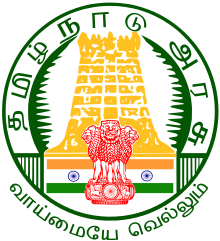Tondaimandalam
Tondaimandalam also known as Tondai Nadu is a historical region located in the southern part of Andhra Pradesh and northernmost part of Tamil Nadu.[1] The region comprises the districts which formed a part of the traditional malayaman kingdom. The boundaries of Tondaimandalam are ambiguous – between the Rivers basins of Penna River and Ponnaiyar River. During the reign of Rajaraja I, this region was called as Jayankonda Cholamandalam.[2]

Geography
The region includes the Nellore, Chittoor, North and South Arcot and Chingleput districts of the Andhra and Madras states (now in Andhra Pradesh and Tamil Nadu).
The Gateway of South India Chennai was part of the region.[1] It covers the present day areas of Nellore, Chittoor, Vellore, Ranipet, Tirupattur, Tiruvanamalai, Villupuram, Kallakuruchi, Tiruvallur, Kanchipuram, Chengalpattu, Cuddalore and Chennai districts of modern-day Andhra Pradesh and Tamil Nadu.
History
Neolithic burial urn, cairn circles and jars with burials dating to the very dawn of the Christian era have been discovered near Mamallapuram.It then came under the rule of Cholas during first century CE with the capital of Tondai Nadu as Kanchipuram. The Proceedings of the First Annual Conference of South Indian History Congress also notes: The word Tondai means a creeper and the term Pallava conveys a similar meaning.[3] In the 3rd century CE, Tondai Nadu was ruled by Ilandiraiyan, the first king with the title "Tondaiman", whom P. T. Srinivasa Iyengar identifies with a Pallava prince. Pallavas moved southwards, adopted local traditions to their own use, and named themselves as Tondaiyar after the land called Tondai.[3][4] The medieval Pallavas ruled Andhra and Northern Tamil Nadu, from the 4th to the 9th centuries, with their seat of capital at ancient Kanchipuram. The ancient Tamil poem of Kalingattuparani mentions the conquest of Telangana by Kulotunga Cholan who handed the reigns of Tondamandalam to his illegitimate son Adondai.[5]
It was captured by the second Chola monarch, Aditya (r. ca. 871-907). he defeated the armies of the Pallavas of Kanchipuram and claimed all of Tondai Nadu; the region north of the Kaveri basin around Palar river basin including present day Chittoor and Nellore district of Andhra Pradesh, as Chola territory.[6] The region was then a part of Vijayanagara Empire, first ruling from Hampi and then headquartered at Chandragiri in present-day Andhra Pradesh. The Vijayanagar rulers who controlled the area, appointed chieftains known as Nayaks who ruled over the different regions of the province almost independently. During the British Rule, the whole region was a part of the Madras Presidency.
References
- Kenneth R Hall. Trade and Spacecraft in the ages of chola. Abhinav publications, 2003. p. 88.
- Alok Tripathi, Archaeological Survey of India, India. Indian Navy. India and the eastern seas. Organising Committee of International Seminar on Marine Archaeology, 2007. p. 49.CS1 maint: multiple names: authors list (link)
- South Indian History Congress, Issue 1. The Congress and The Madurai Kamaraj University Co-op Printing Press. 1980.
- A. Krishnaswami (1975). Topics in South Indian history: from early times up to 1565 A.D. Krishnaswami. pp. 89–90.
- Madras Journal of Literature and Science, Volume 14. Vepery mission Press. 1847.
- "Restoring past glory". The Hindu. 2 October 2001.
